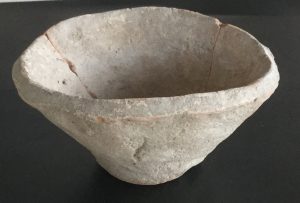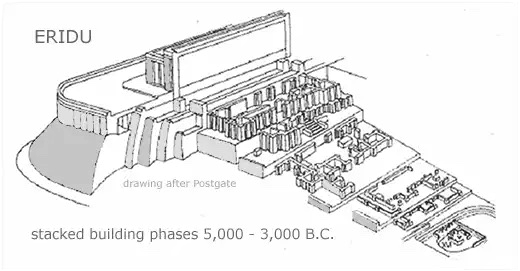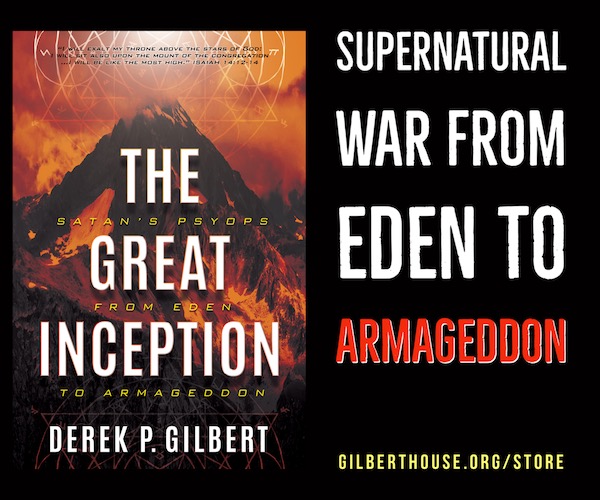The end of the Sumerian poem Enmerkar and the Lord of Aratta is mostly missing, but it appears that Enmerkar ultimately triumphed over his rival. Other stories suggest that Enmerkar, who I believe was the biblical Nimrod (I make that case in my book, The Great Inception), later marched the army of Uruk to Aratta and conquered it.

This is consistent with archaeological evidence of the Uruk Expansion, which covers the period from about 3500 BC to about 3100 BC. Although scholars usually downplay the violence that created the world’s first empire, Uruk spread its influence as far away as northwest Iran and southeastern Turkey. Pottery from Uruk has been found are more than 500 miles away from the city. To put it into context, the kingdom of Uruk at its peak was bigger than Iraq under Saddam Hussein.
This was not always a peaceful endeavor. An ancient city called Hamoukar in northeast Syria was destroyed and burned by an army from Uruk sometime around 3500 BC. Scholars have identified the origin of the army by the pottery they left behind. Hamoukar was overwhelmed and then burned by attackers who used clay bullets fired from slings to defeat the city’s defenders. Strangely, what appears to have been a trading post from Uruk outside the city was destroyed, too, suggesting that maybe the men sent by Uruk to keep the locals in line had gone native.
That was how the kingdom of Nimrod obtained materials like jewels, copper, silver, lead, gold, timber, wine, and other things that were scarce in the plains of Sumer.
Of course, there is no way we’ll ever know for certain that Nimrod was Enmerkar, and that he was responsible for the Uruk Expansion—which is a nice way of describing the process of conquering everybody within a two-month march of home. Artifacts from Uruk are found everywhere in the Near East, especially a type of pottery called the beveled-rim bowl. This is significant because it offers a glimpse into the way the society of Uruk was organized.
Scholars have found that the society just before the Uruk period, the Ubaid culture, became more stratified as people moved from rural settlements to cities. The Ubaid civilization produced high-quality pottery, identified by black geometric designs on buff or green-colored ceramic. In contrast, around 3500 BC, the Uruk culture developed the world’s first mass-produced product, the beveled-rim bowl.
The beveled-rim bowl is crude compared to the pottery from the Ubaid culture, but archaeologists have found a lot of them. About three-quarters of all pottery found at Uruk period sites are beveled-rim bowls. Scholars agree that these simple, undecorated bowls were made in molds rather than on wheels, and that they were probably used to measure out barley and oil for workers’ rations.
The way they were produced left the hardened clay too porous to hold liquids like water or beer. (Yes, the Sumerians brewed beer. Enki’s alternate name, Nudimmud, is a compound word: nu = “likeness” + dim = “make” + mud = “beer.” One could argue that Enki is the spirit of our age.) The bowls were cheap and easy to make, so much so that they may have been disposable. At some archaeological sites, large numbers of used, unbroken bowls have been found in big piles. Basically, these cheap bowls were the Sumerian version of Styrofoam fast-food containers.
The concept of measuring out rations implies an employer or controlling central authority responsible for doling out grain and oil to laborers. It’s not a coincidence that the development of these crude bowls happened alongside Uruk’s emergence as an empire. After the flood, which we theorize marked the end of the Ubaid period, people again gravitated to urban settlements where they apparently exchanged their freedom for government rations.
It looks like that’s how Nimrod and his successors, including Gilgamesh, controlled their subjects—moving them off the land and into cities, keeping a tight rein on the means of production and distribution of food and resources.
Now, it’s possible we’re reading more into the evidence than is truly there. It could be that the beveled-rim bowl was nothing more than an easy way for people to carry lunch to work. Will future archaeologists conclude that Americans were paid in carry-out hamburgers because of the billions of Styrofoam containers in our landfills?
Still, given the unprecedented growth of the Uruk empire between about 3500 BC and 3100 BC, it’s not going too far to speculate that the use of mass-produced ration bowls was a symptom of the stratification of society under the rule of Nimrod/Enmerkar and his successors. As in the Ubaid culture, citizens of Uruk found themselves working for hereditary leaders—kings, who justified their rule as ordained by the gods.
As an example, the Sumerian myth Enki and Inanna tells the story of how the divine gifts of civilization, the mes (sounds like “mezz”), were stolen from Enki by the Inanna and transferred from Eridu to Uruk. Enki, always ready for a romp with a goddess, tried to ply Inanna with beer. She maintained her virtue while Enki got drunk, offering her gift after gift as his heart grew merry and his mind grew dim. When he awoke the next day with a hangover, Inanna and the mes were no longer in the abzu. The enraged god sent out his horrible gallu demons (sometimes translated “sea monsters”) to retrieve them, but Inanna escaped and arrived safely back at Uruk, where she dispensed the hundred or so mes to the cheers of a grateful city. Enki realized he’d been duped and accepted a treaty of everlasting peace with Uruk. This tale may be a bit of religious propaganda to justify the transfer of political authority to Uruk.

One more thing: We mentioned earlier that archaeologists at Eridu have found 18 construction layers at the site of Enki’s temple. Some of those layers are below an eight-foot deposit of silt from a massive flood. The most impressive layer of construction, called Temple 1, was huge, a temple on a massive platform with evidence of an even larger foundation that would have risen up to almost the height of the temple itself.
Here’s the thing: Temple 1 was never finished. At the peak of the builders’ architectural achievement, Eridu was suddenly and completely abandoned.
… the Uruk Period … appears to have been brought to a conclusion by no less an event than the total abandonment of the site. … In what appears to have been an almost incredibly short time, drifting sand had filled the deserted buildings of the temple-complex and obliterated all traces of the once prosperous little community.[1]
Why? What would possibly cause people who’d committed to building the largest ziggurat in Mesopotamia at the most ancient and important religious site in the known world to just stop work and leave Eridu with the E-abzu unfinished? Could it be…
“Come, let us go down and there confuse their language, so that they may not understand one another’s speech.” So the Lord dispersed them from there over the face of all the earth, and they left off building the city.
Genesis 11:8–9 (ESV)
To the Sumerians, and later the Akkadians and Babylonians (who knew him as Ea), Enki was the supernatural actor with the most influence on human history. He was the caretaker of the divine gifts of civilization, the mes (at least until he was tricked by Inanna), and he retained enough prestige for powerful men to justify their reign by claiming kingship over his city, Eridu, for 2,500 years after the city around the temple complex was abandoned.
For one moment in human history, Enki induced a human dupe—Nimrod, the Sumerian king Enmerkar—to build what he hoped would be a new abode of the gods, the bāb ilu, to rival Yahweh’s mount of assembly. It was to be the heart of a one-world totalitarian government.
Yahweh put a stop to it. But as George Santayana wrote, “Those who cannot remember the past are condemned to repeat it.”
The sin of Nimrod is being repeated today by the globalist movement, which is slowly but surely leading us back to Babel.
[1] Safar, Fuʼād; Lloyd, Seton; Muṣṭafá, Muḥammad ʻAlī; Muʼassasah al-ʻĀmmah lil-Āthār wa-al-Turāth. Eridu. Republic of Iraq, Ministry of Culture and Information, State Organization of Antiquites and Heritage, Baghdad, 1981.


Thank you. It is a nice informative article
Derek: this is wonderful history. It’s captivating , motivating and so…interesting. Ancient culture mirroring modernity. What a concept. Thanks for sparking a keen interest in me. Warm Regards, Keith
You made a mistake in the article, it is Yaweh that is the force of Evil.
In the summerian history, enki is the creator of humanity, and also the one that gave it technology to survive the flood that would be used to drive humanity to extinction, by the order of Yaweh.
In Sumerian history, it was Enlil who ordered the extinction of humanity. There is no mention of Yahweh in any Sumerian text, although I believe the sky-god Anu is a distorted memory of Yahweh.